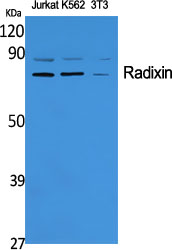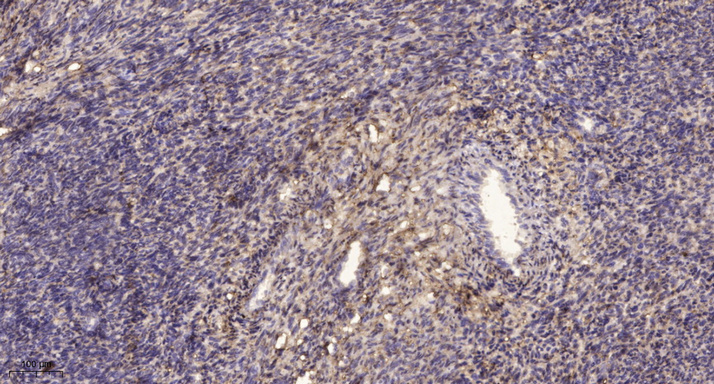Radixin Polyclonal Antibody
- Catalog No.:YT3973
- Applications:WB;ELISA;IHC
- Reactivity:Human;Mouse;Rat
- Target:
- Radixin
- Fields:
- >>Tight junction;>>Regulation of actin cytoskeleton;>>Proteoglycans in cancer;>>MicroRNAs in cancer
- Gene Name:
- RDX
- Protein Name:
- Radixin
- Human Gene Id:
- 5962
- Human Swiss Prot No:
- P35241
- Mouse Gene Id:
- 19684
- Mouse Swiss Prot No:
- P26043
- Immunogen:
- The antiserum was produced against synthesized peptide derived from human RDX. AA range:142-191
- Specificity:
- Radixin Polyclonal Antibody detects endogenous levels of Radixin protein.
- Formulation:
- Liquid in PBS containing 50% glycerol, 0.5% BSA and 0.02% sodium azide.
- Source:
- Polyclonal, Rabbit,IgG
- Dilution:
- WB 1:500-2000;IHC 1:50-300; ELISA 2000-20000
- Purification:
- The antibody was affinity-purified from rabbit antiserum by affinity-chromatography using epitope-specific immunogen.
- Concentration:
- 1 mg/ml
- Storage Stability:
- -15°C to -25°C/1 year(Do not lower than -25°C)
- Other Name:
- RDX;Radixin
- Observed Band(KD):
- 69kD
- Background:
- Radixin is a cytoskeletal protein that may be important in linking actin to the plasma membrane. It is highly similar in sequence to both ezrin and moesin. The radixin gene has been localized by fluorescence in situ hybridization to 11q23. A truncated version representing a pseudogene (RDXP2) was assigned to Xp21.3. Another pseudogene that seemed to lack introns (RDXP1) was mapped to 11p by Southern and PCR analyses. Multiple alternatively spliced transcript variants encoding different isoforms have been found for this gene. [provided by RefSeq, May 2012],
- Function:
- disease:Defects in RDX are the cause of non-syndromic sensorineural deafness autosomal recessive type 24 (DFNB24) [MIM:611022]. DFNB24 is a form of sensorineural hearing loss. Sensorineural deafness results from damage to the neural receptors of the inner ear, the nerve pathways to the brain, or the area of the brain that receives sound information.,domain:The N-terminal domain interacts with the C-terminal domain of LAYN. An interdomain interaction between its N-terminal and C-terminal domains inhibits its ablilty to bind LAYN. In the presence of acidic phospholipids, the interdomain interaction is inhibited and this enhances binding to LAYN.,function:Probably plays a crucial role in the binding of the barbed end of actin filaments to the plasma membrane.,PTM:Phosphorylated by tyrosine-protein kinases.,similarity:Contains 1 FERM domain.,subcellular location:Highly concentrated in the un
- Subcellular Location:
- Cell membrane; Peripheral membrane protein; Cytoplasmic side. Cytoplasm, cytoskeleton. Cleavage furrow. Cell projection, microvillus . Highly concentrated in the undercoat of the cell-to-cell adherens junction and the cleavage furrow in the interphase and mitotic phase, respectively.
- Expression:
- Brain,Hippocampus,Liver,Lung,Testis,Uterus,
- June 19-2018
- WESTERN IMMUNOBLOTTING PROTOCOL
- June 19-2018
- IMMUNOHISTOCHEMISTRY-PARAFFIN PROTOCOL
- June 19-2018
- IMMUNOFLUORESCENCE PROTOCOL
- September 08-2020
- FLOW-CYTOMEYRT-PROTOCOL
- May 20-2022
- Cell-Based ELISA│解您多样本WB检测之困扰
- July 13-2018
- CELL-BASED-ELISA-PROTOCOL-FOR-ACETYL-PROTEIN
- July 13-2018
- CELL-BASED-ELISA-PROTOCOL-FOR-PHOSPHO-PROTEIN
- July 13-2018
- Antibody-FAQs
- Products Images

- Immunofluorescence analysis of Siha cell. 1,primary Antibody was diluted at 1:100(4°C overnight). 2, Goat Anti Rabbit IgG (H&L) - AFluor 594 Secondary antibody(catalog No: RS3611) was diluted at 1:500(room temperature, 50min).

- Western Blot analysis of various cells using Radixin Polyclonal Antibody diluted at 1:2000
.jpg)
- Western Blot analysis of HuvEc cells using Radixin Polyclonal Antibody diluted at 1:2000

- Western blot analysis of lysates from HUVEC cells, using RDX Antibody. The lane on the right is blocked with the synthesized peptide.

- Western blot analysis of the lysates from HT-29 cells using RDX antibody.

- Immunohistochemical analysis of paraffin-embedded human uterus. 1, Antibody was diluted at 1:200(4° overnight). 2, Tris-EDTA,pH9.0 was used for antigen retrieval. 3,Secondary antibody was diluted at 1:200(room temperature, 45min).



